What is still not well-known?
As in other fields of science, our knowledge of immunology is constantly advancing in tandem with developments in technology. Despite the significant progress achieved over recent years, there are many questions still to be answered in this exciting science. In this chapter we will review some of these challenges, starting with the cells of the immune system and ending with protective mechanisms.
|
|
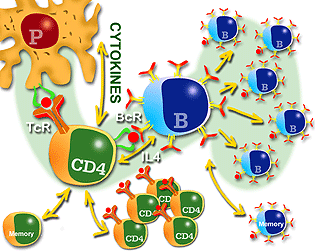
Diagram of cell cooperation in the adaptive immune response. |
There are still some areas to be clarified concerning the cells of the immune system. More specifically, the a-b and g-d lymphocyte receptors and antigen-presenting cells (APC), in particular dendritic cells, will help us to better understand the mechanisms of cell collaboration in the immune response. |
|

ANTIGEN PRESENTATION IN THE INDUCTOR AREA OF THE MUCOUS MEMBRANES. Antigens penetrating the enterocytes are quickly destroyed by the lysosomes. However, antigens captured by the M cells are transported without being broken down and are presented to intraepithelial lymphocytes. They are then passed to the lymph nodes. |
Another of the challenges of porcine immunology is to find out more about the mechanisms of immunity of the mucosae related to antigen transport and infection pathways that enable an increase in antigenic stimulation at that level and a better immune response.
In terms of our understanding of porcine immunoglobulins, advances need to be made in the study of IgE immunoglobulin, which up to now has only been studied indirectly. Other priorities are studying definitively whether porcine IgD exists or not and gaining more information on the protector role of IgA immunoglobulin.
Another key challenge in the field of porcine immunology is advancement in knowledge of the cytokines as only 19 have been cloned in pigs. One subject requiring further research is to gain more knowledge on how they are involved in the innate and adaptive response, in hematopoiesis and in lymphocyte activation.
|
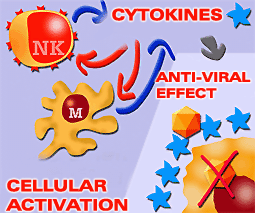
Cytokines play a key role in the natural response through direct action mechanisms against the invading agent (preventing the infection of the cells by viruses) or through cell activation mechanisms (NK and macrophages) which in turn release cytokines |
|

One of the activities of cytokines is their ability to attract different cells of the immune system.
|
|
|
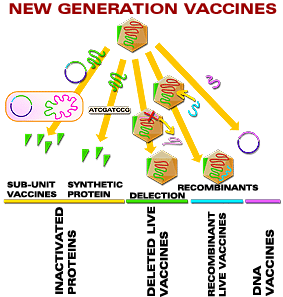
Diagram of the different types of new generation vaccines |
Finally, more needs to be understood of immune mechanisms against infectious and parasitic agents. Parasites are of particular interest. Due to their complex antigenic structure and diverse life cycles, they induce various mechanisms of immune response evasion, using intracellular infections or changes in their antigenic structure. These strategies are not understood in great depth. Parasitic immunology is another of the challenges requiring study. In addition, finding more effective vaccines against bacterial and viral agents (there are still areas to be clarified in many diseases) is another of the aspects requiring further research. DNA vaccines will probably represent an excellent option in the near future. |
|
| Where will immunological studies go from here? |

Diagram of monoclonal antibody production
|
Advances and developments in new technology will allow us to better understand the subjects described previously, as well as many others still to be fully resolved. Advances in genetic engineering enabe the cloning and expression of different genes. The role of the proteins coded by them can therefore be discovered. Genetic engineering also enables the development of transgenic experimental animals which have either had genes suppressed and therefore do not express a certain regulatory gene (null or "knock out" animals), or have had a specific gene incorporated. These are some of the new technologies available which will undoubtedly help with advances in our knowledge of the immune response.
In addition, we should not forget the vitally important role of the monoclonal antibodies in the study of different lymphocyte populations and sub-populations, as well as our understanding of the different antigen epitopes and of syngeneic animals for the histocompatibility system. Thanks to all of these techniques, our knowledge of porcine immunology will continue to advance. As is the case with all life sciences, this field is constantly developing. |
|
| What role will the pig play in the future? |
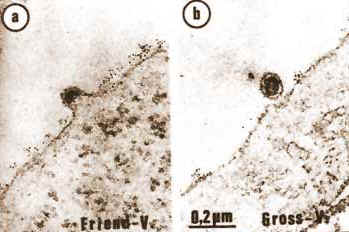
Image of retrovirus using electron microscope |
Amongst these advantages are: ease of reproduction, compatible size with humans, a lower risk of cross infections (with the exception of porcine endogenous retrovirus, whose impact on health is currently being studied) and the possibility of producing transgenic or polytransgenic pigs which express different genes to prevent hyperacute rejection or acute vascular rejection; these are currently the main problems of xenotransplantation. Transgenic pigs with DAF "Decay accelerating factor" now exist. DAF inhibits the formation of the C3 and C5 convertases, therefore breaking the activation of the complement cascade at the level of both pathways which would lead to hyperacute rejection.
The previous points allow us to suggest that the study of pigs will play a key role over the next few years in the scientific strategy of most industrialized countries. |
|

Photo of a baboon. This species was once considered the principal candidate for xenotransplants to humans. |
|
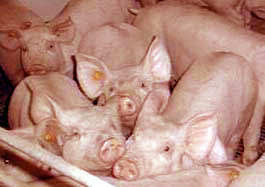
Nowadays, transgenic pigs and especially polytransgenic pigs in the future seem to be the animal species most likely to be a donor of xenotransplants to humans. |
|
|

